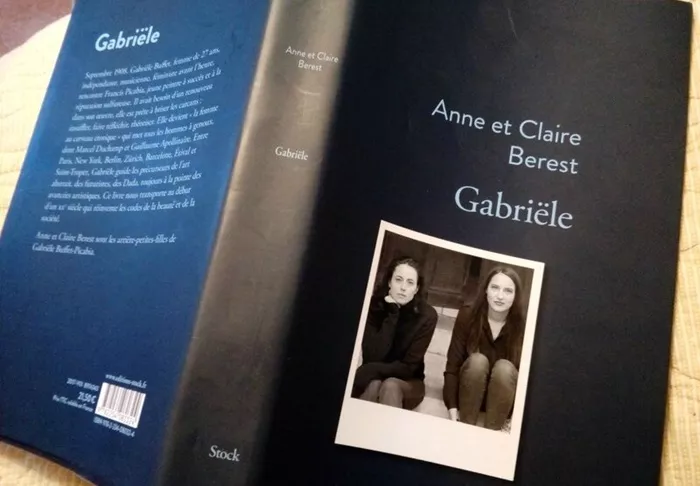Claire and Anne Berest, authors of the highly acclaimed The Postcard, now turn their attention to a pivotal figure in their family’s past: their great-grandmother, Gabriële Buffet-Picabia. Through their latest work, Gabriële, the sisters reveal a fascinating exploration of a woman whose influence in the world of modern art and avant-garde movements was overshadowed by the turbulent personal and artistic relationship she shared with her husband, the famed painter Frances Picabia.
Although the Berest sisters never knew their grandfather, Vincente—the son of Gabriële and Picabia—his legacy haunted their family. Vincente’s tragic suicide occurred long before they were born, and aside from the distant memories of their grandmother, Myriam, who survived the Holocaust, the sisters were left with little understanding of this branch of their heritage. Gabriële is their attempt to bridge the gap, unearthing the life of a woman who was once at the heart of Parisian modernist circles but whose own story had remained largely unknown.
The Genesis of Gabriële and The Postcard
The quest to uncover their great-grandmother’s life began after Anne Berest’s bestselling novel The Postcard (2021), which delves into her grandmother’s experiences during and after the Holocaust. Myriam, who had lost her entire family, rarely spoke about her past, but the arrival of a postcard with the names of her deceased relatives set Anne on a path of investigation into her family’s history. This personal journey, alongside a troubling anti-Semitic incident involving her daughter, spurred Anne to seek out the stories that had been hidden or suppressed.
For Gabriële, Anne teamed up with her sister Claire, an established author in her own right, to explore the life of their enigmatic great-grandmother. The novel offers a portrait of a woman whose intellectual vitality and artistic collaboration with Picabia helped shape early 20th-century modernist art. Born into a world of music and composition, Gabriële defied societal norms, studying in Paris and Berlin at a time when opportunities for women in the arts were limited. Her encounter with Picabia led to a partnership marked by intellectual challenge, creative tension, and personal sacrifice, but also one that would have a profound impact on the evolution of modern art.
An Intellectual Powerhouse Amid Personal Turmoil
Gabriële weaves the narrative of a gifted woman who was both a muse and an intellectual equal to Picabia. While her artistic achievements may have been overshadowed by Picabia’s fame, she played a key role in his transition toward abstraction, surrealism, and Dadaism—movements that would define the trajectory of modernism. Despite his infidelity, addiction, and neglect of their children, Gabriële remained deeply devoted to him, even after their divorce. Her life was marked by intellectual vigor and emotional resilience, traits that are vividly brought to life in the novel.
One of the most striking aspects of Gabriële’s story is her complex relationship with Picabia. While she never fully embraced the role of his muse in the conventional sense, her influence on his work is undeniable. The pair’s unconventional parenting—leaving their children largely in the care of nannies or Gabriële’s mother—stands in stark contrast to the vibrant artistic community they inhabited. Despite her personal sacrifices, Gabriële continued to be a central figure in the bohemian circles of early 20th-century Paris and later, New York.
A Novel of Ideas and Historical Reconstruction
Though rooted in historical fact, Gabriële is written as a novel. The Berest sisters have drawn on Gabriële’s unpublished letters and existing historical documents to reconstruct her life, blending historical accuracy with imaginative interpretation. The novel engages deeply with the intellectual currents of the time, particularly in its exploration of Duchamp’s groundbreaking work, Nude Descending a Staircase. This analysis is one of the book’s most compelling features, offering fresh perspectives on the era’s most iconic artworks.
The novel also touches on Gabriële’s role in the French Resistance, a theme that Anne Berest had previously explored in The Postcard. However, the Berests have hinted that Gabriële’s involvement in the Resistance may be the subject of future work, suggesting the potential for a continuation of this family saga.
The Berest Sisters Reflect on Their Legacy
While Gabriële centers on the life of their great-grandmother, it also offers a subtle meditation on the Berest sisters’ own artistic inheritance. Throughout the novel, the sisters occasionally interject their reflections on the process of uncovering their family’s past. This meta-narrative, in which the authors emerge as characters in their own story, provides a personal dimension to the historical investigation.
In some ways, Gabriële is as much a story of the Berest sisters’ relationship with their own artistic heritage as it is a portrait of their great-grandmother. Their exploration of the Picabia-Buffet legacy raises thought-provoking questions about family, art, and the complexities of inheritance. Given the sisters’ engaging storytelling and intellectual curiosity, the possibility of a sequel focusing on their own artistic and personal journeys would be a welcome continuation of the themes explored in Gabriële.
Gabriële is a testament to the Berest sisters’ commitment to uncovering the hidden stories of their past. It is a richly layered narrative that sheds light on a fascinating historical figure while reflecting on the broader themes of artistic legacy, personal sacrifice, and intellectual discovery.

